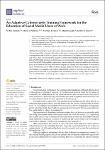An Adaptive Cybersecurity Training Framework for the Education of Social Media Users at Work
| dc.contributor.author | Ben Salamah, F | |
| dc.contributor.author | PALOMINO, MARCO | |
| dc.contributor.author | Craven, Matthew | |
| dc.contributor.author | Papadaki, Maria | |
| dc.contributor.author | Furnell, Steven | |
| dc.date.accessioned | 2023-08-29T17:44:07Z | |
| dc.date.available | 2023-08-29T17:44:07Z | |
| dc.date.issued | 2023-08-24 | |
| dc.identifier.issn | 2076-3417 | |
| dc.identifier.issn | 2076-3417 | |
| dc.identifier.other | ARTN 9595 | |
| dc.identifier.uri | https://pearl.plymouth.ac.uk/handle/10026.1/21267 | |
| dc.description.abstract |
Formalizing the approach towards risk management on social media is critical for organizations. Regrettably, a review of the state-of-the-art on cybersecurity training highlighted that the existing frameworks are either too generic or too cumbersome to be adapted to different organizations and needs. Thus, we developed the Adaptive Cybersecurity Training Framework for Social Media Risks (ACSTF-SMR), a framework that incorporates social media cybersecurity policies and best practices. The ACSTF-SMR enables organizations, trainers, and policymakers to address the challenges posed by social media in a way that satisfies employees’ training needs and adjusts to their preferences. We tested the ACSTF-SMR with 38 case studies. Employees’ behaviors, learning, and responses after training were assessed, and feedback was gathered to improve the framework. Interviews with policymakers were held to gain insight into the enforcement of social media policies. We conclude that the ACSTF-SMR is a reliable option to mitigate social media threats within organizations. | |
| dc.format.extent | 9595-9595 | |
| dc.language | en | |
| dc.publisher | MDPI AG | |
| dc.subject | cybersecurity | |
| dc.subject | adaptive training | |
| dc.subject | social media | |
| dc.subject | education | |
| dc.title | An Adaptive Cybersecurity Training Framework for the Education of Social Media Users at Work | |
| dc.type | journal-article | |
| dc.type | Journal Article | |
| plymouth.author-url | https://www.webofscience.com/api/gateway?GWVersion=2&SrcApp=PARTNER_APP&SrcAuth=LinksAMR&KeyUT=WOS:001060981200001&DestLinkType=FullRecord&DestApp=ALL_WOS&UsrCustomerID=11bb513d99f797142bcfeffcc58ea008 | |
| plymouth.issue | 17 | |
| plymouth.volume | 13 | |
| plymouth.publication-status | Published online | |
| plymouth.journal | Applied Sciences | |
| dc.identifier.doi | 10.3390/app13179595 | |
| plymouth.organisational-group | |Plymouth | |
| plymouth.organisational-group | |Plymouth|Faculty of Science and Engineering | |
| plymouth.organisational-group | |Plymouth|Faculty of Science and Engineering|School of Engineering, Computing and Mathematics | |
| plymouth.organisational-group | |Plymouth|REF 2021 Researchers by UoA | |
| plymouth.organisational-group | |Plymouth|Users by role | |
| plymouth.organisational-group | |Plymouth|Users by role|Academics | |
| plymouth.organisational-group | |Plymouth|REF 2021 Researchers by UoA|UoA10 Mathematical Sciences | |
| plymouth.organisational-group | |Plymouth|REF 2021 Researchers by UoA|UoA11 Computer Science and Informatics | |
| plymouth.organisational-group | |Plymouth|REF 2021 Researchers by UoA|ZZZ Extended UoA 10 - Mathematical Sciences | |
| dcterms.dateAccepted | 2023-08-23 | |
| dc.date.updated | 2023-08-29T17:44:07Z | |
| dc.rights.embargodate | 2023-8-31 | |
| dc.identifier.eissn | 2076-3417 | |
| dc.rights.embargoperiod | forever | |
| rioxxterms.versionofrecord | 10.3390/app13179595 |


